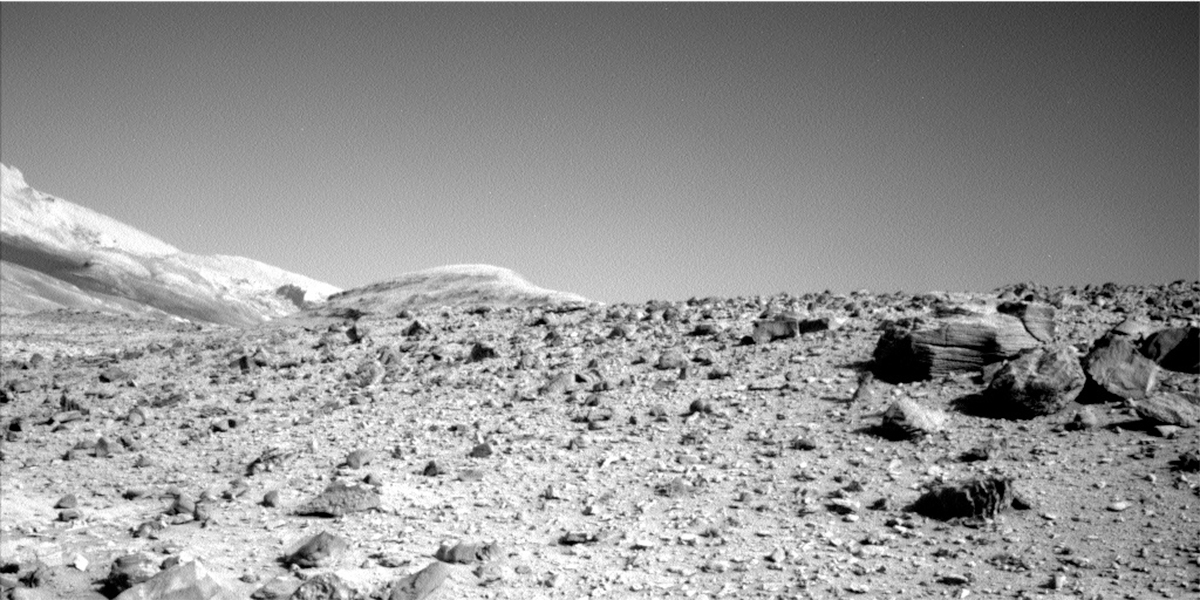3 min read

Earth planning date: Friday, August 18, 2023
The Gediz Vallis Ridge has been a long-term, and, at times, seemingly impossible goal of the Curiosity Rover mission. Our path to it has repeatedly been diverted from our first difficult climb onto the Greenhugh Pediment way back in 2020, our dead-end foray onto and across the pediment through a steep side ravine of the Gediz Vallis, ultimately blocked by the potentially wheel-eating “Gatorback” ridges in 2022, and finally to our recent slip-and-slide circuitous climb out of the Marker Band Valley onto the Gedis Vallis ridge itself. The team today called GV Ridge the “Bermuda Triangle” of Mt. Sharp. We are now just a few meters away from being able to reach the arm out and get contact science on some of the ridge material, and anticipation is growing.
The drive on Sol 3921 ended a few meters short of our destination cluster of boulders due to some sideways sliding en-route. The uncertain footing also left our wheels unsafe to support a deployment of Curiosity’s arm, so all of our weekend science activities will be via targeted remote sensing rather than use of the arm’s instruments for more detailed study. Mastcam is taking this opportunity to perform a 360 degree panorama, which should be spectacular! Mastcam will also have large mosaics targeted at the transition between the dark “float” rock ridge material and the underlying sulfate-bearing bedrock, as well as multispectral imaging of the nearby “Skiathos” and “Skopelos” boulders. ChemCam will zap those same rocks with its laser to study a possible surface coating and compositional variations between rock layers. ChemCam will also use the telescopic mode of its RMI camera to zoom in on a light colored bedrock wall adjacent to a basin of dark sand and to continue its characterization of the amazing layering on Kukenan Butte. Meanwhile, Navcam will take some dust devil movies and a measurement of dust in the air across Gale Crater, as well as imaging of clouds and their shadows on the beautiful peaks around us.
Another short 2 m drive, which the team calls a “bump,” will finally place Curiosity within arm’s reach of the boulder collection on Sol 3924. Following our usual set of post-drive observations, Curiosity will perform AEGIS and MARDI imaging on Sol 3925 to further document the geology of our new location. We end the plan in the early morning of Sol 3926 with a set of atmospheric observations, including a dust measurement and a Navcam 360 phase function sky survey.
With Monday’s plan, Curiosity will hopefully be able to finally perform contact science on a diverse cluster of GV Ridge boulders, presuming that our drive is successful and doesn’t leave our wheels perched on any of the abundant rocks on this steep slope. Another remaining challenge is a very tiny decisional downlink on Monday, giving us very little data to decide on our next steps. In addition, on Monday, JPL is in the bullseye of the very first tropical storm watch to ever be posted in Southern California by the National Hurricane Center. Fingers crossed that the “GV Ridge Triangle” will not claim another MSL plan before Curiosity reaches the top!
Written by Deborah Padgett, OPGS Task Lead at NASA's Jet Propulsion Laboratory







